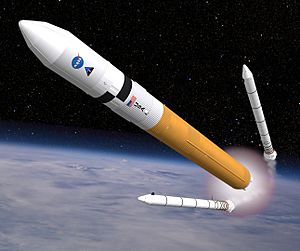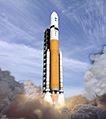Ares V facts for kids

Artist's impression of an Ares V during solid rocket booster separation
|
|
| Function | Cargo Launch Vehicle |
|---|---|
| Country of origin | United States |
| Size | |
| Height | 116 m (381 ft) or 109 m (358 ft) |
| Diameter | 10 m (33 ft) or 8.4 m (28 ft) |
| Stages | 2 |
| Capacity | |
| Payload to LEO | 188,000 kg (414,000 lb) |
| Payload to TLI | 71,100 kg (156,700 lb) or 60,600 kg (133,600 lb) |
| Launch history | |
| Status | Canceled |
| Launch sites | Kennedy Space Center, LC-39B |
| Boosters – 5- or 5.5-segment Shuttle-derived SRB | |
| Engines | 1 solid |
| Fuel | APCP (solid) |
| First stage | |
| Engines | 5 or 6 RS-68B or 5 SSME (RS-25) |
| Thrust | 8,350 kN (1,880,000 lbf) or 10,350 kN (2,330,000 lbf) upper atmosphere (figures for RS-25) |
| Fuel | LH2/LOX |
| Second stage – Earth Departure Stage | |
| Engines | 1 or 2 J-2X |
| Fuel | LH2/LOX |
The Ares V was a very powerful cargo rocket that NASA planned to build. It was part of the Constellation program, which aimed to send astronauts back to the Moon. The Ares V was designed to carry heavy equipment, like the Earth Departure Stage and the Altair lunar lander, for Moon missions. The plan was to return to the Moon around 2019.
This rocket was meant to work alongside the Ares I rocket, which was designed to carry astronauts. Both Ares rockets were chosen because they were expected to be safe, reliable, and cost-effective.
The Ares V was planned to be able to lift about 188,000 kilograms (414,000 pounds) into Low Earth orbit (LEO). It could also carry about 71,000 kilograms (157,000 pounds) all the way to the Moon. If it had been built, the Ares V would have been the most powerful rocket ever, able to lift more weight into space than even the famous Saturn V rocket. The Ares V, Ares IV, and Ares I rockets were all named after Ares, the Greek god of war, who is similar to the Roman god Mars.
Related pages
Images for kids
-
Comparison of Saturn V, Space Shuttle, Ares I, Ares IV and Ares V
See also
 In Spanish: Ares V para niños
In Spanish: Ares V para niños



